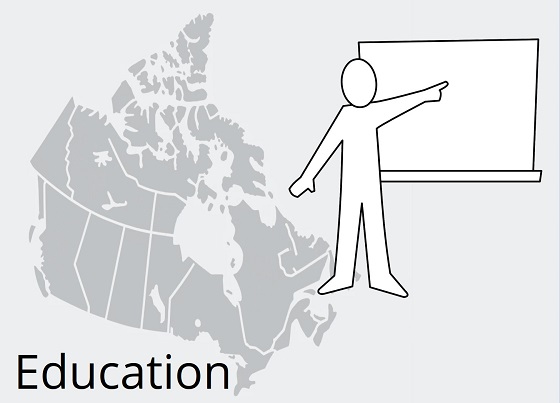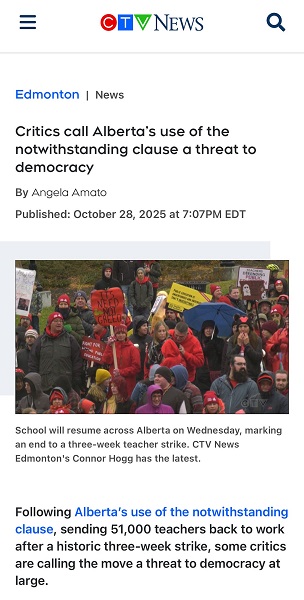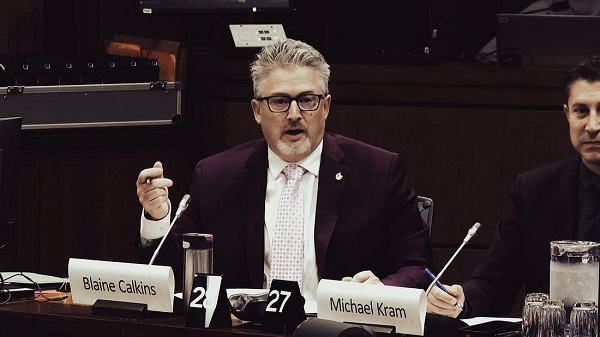Education
Rethinking Public Education

From The Audit
Holding public officials and institutions accountable using data-driven investigative journalism
What should public education accomplish?
On any given school day some six million Canadians between the ages of 5-18 are “locked up” – often against their will – inside K-12 schools. Approximately 2.5 percent of Canada’s gross domestic product is spent on public education. And, using Ontario as an example, that’ll cost more than $30 billion annually, or around 16 percent of the province’s budget.
Society invests heavily in education, and yet no one seems completely satisfied with the results. When was the last time you met an adult of any political stripe who didn’t have an opinion about what’s wrong with schools these days?
This piece was inspired by a comment to my recent Ranking Public Education Efficiency By Province post. That’s where I presented evidence suggesting increased funding would probably not solve the deep, systemic problems casting gloomy shadows up and down the halls of our ministries of education.
The Audit is a reader-supported publication. To receive new posts and support my work, consider becoming a free or paid subscriber.
So is there a better way to do public education? I honestly don’t know. But I do know that it’s unlikely we’ll ever find out if we don’t go back to the very beginning as ask some basic questions. And I also know that I haven’t seen most of these particular questions asked anywhere else:
What should public education accomplish?
How do you plan a trip if you don’t know where you want to go?
We can probably agree that all children should learn the skills they’ll need to live productive and successful lives as adults. And there’s not a lot of controversy in saying that those skills should include competence in reading, writing, and basic mathematics.
We can probably also agree that students should graduate with a healthy civic identity which would include comfort with, and loyalty to our cultural and legal heritage. However, things will get prickly when we try to define exactly what we mean by “identity” and “cultural”. Not to mention “heritage”. How do we decide whose definitions win?
Some will argue that schools should teach only skills and leave values out of the curriculum altogether. In other words, education should be culturally neutral. The biggest problem with that is that teachers aren’t neutral. Having taught high school for 20 years myself, I can tell you that, by design or by accident, a teacher enters the classroom as a complete and unsegmented person. And even the drowsiest, most distracted student senses it.
Some go a step further and advocate for teaching children the “critical thinking skills” they’ll need to make their own value judgments. Well that’s fine if you’re providing only the relevant epistemological, semantic, cognitive, and heuristic tools. But if your “critical thinking” curriculum includes even one values-based answer (see above for “unsegmented teachers”) then, by definition, you’re a propagandist.
What, exactly, is wrong with what we’ve already got?
There’s a lot here about which I simply don’t have enough clarity:
- I’ve read that grade inflation is allowing students to graduate without having mastered the content to which their transcripts attest. But I haven’t been able to find hard data to assess the claims.
- I’ve heard that employers are unsatisfied with the skills and work ethic of the young graduates applying for jobs. But how many employers? And how unsatisfied are they?
- As a (former?) IT system administrator, I’m well aware that large-scale technology adoptions in education environments were, historically, often the product of vendor hype, unreasonable expectations, and precious little serious research. And they often led to outrageous unintended consequences. But I’m no longer sufficiently plugged in to that world to have a sense of whether, on aggregate, technology is helping or harming children (or simply draining budgets).
- I’ve heard that at least some school boards appear to be dominated by extreme politically-driven ideologies. But how many boards are impacted? And how often do those ideologies find their way into classrooms?
- I’ve seen evidence that Ministry-level policy research is relying on poor and debunked scholarship. But has it made a difference with anyone involved with actual classroom teaching? (And how do you measure “debunked”?)
Should control over education policy be centralized?
Curriculum policy in Canada is generally set at the provincial ministry level and politely ignored everywhere else. I’ve already written about that in these pages. But, as discussed earlier, K-12 policy development costs us hundreds of millions of dollars each year across the country.
I’m not sure it’s even possible to impose detailed policy and curriculum guidelines. As a wise man once told me, you can tell them exactly what you want them to say but, with an arched eyebrow or a subtle voice inflection, experienced teachers communicate whatever message they want.
Now, considering how the system is currently funded, it makes perfect sense that elected officials at the provincial level should determine education policy. What makes somewhat less sense is that the policy researchers they hire appear to invest a great deal of energy resisting government “interference” and also refuse to share their research with the public who paid for it.
But, in theory at least, is the current system ideal?
Let me take a step back. What exactly is an education expert whose opinions qualify as authoritative? The issue is complicated by the many popular pedagogical theories that have come and (in some cases) gone over the decades. Those include constructivism, behaviorism, social learning theory, cognitive load theory, multiple intelligences theory, experiential learning theory, connectivism, situated learning theory, Bloom’s taxonomy, and humanistic education.
However I don’t believe that any single one of those – or even a combination – has ever achieved any kind of lasting consensus as they they cycle in and out of popularity. Nor can it be claimed that the policies set by whoever the credentialed experts happen to be have led to consistently satisfying results.
That is certainly not to suggest that the experts’ guidance hasn’t delivered successes over the years, or that they don’t bring value to the table. But, after more than a century’s worth of experiments with centralized educational control, it might be time to try something else.
Are all teenagers best served by mandatory enrollment?
When we acknowledge that no two children have identical needs and potential, it means that we have to be ready to treat them differently. And that’ll involve more than sending some kids to room 310 for their 10:30 class and others to room 315 across the hall. Isn’t it reasonable to wonder whether some teenagers can learn more and transition faster to responsible adult life outside educational frameworks?
Perhaps some truancy and child labour laws need updating.
Do vested interests stand in the way of positive change?
I honestly don’t know enough to have solid opinions on these questions, but they must be asked:
- Are teachers colleges politicized?
- Do the incentives driving powerful teachers unions conflict with students’ needs?
- Are sharply competing visions within ministries of education paralyzing the system (and wasting resources)?
- Should parent-advocates be allowed to interfere with educational professionals doing their work?
- Can every ministry job category still justify its costs – in both budget and institutional friction?
The inexorable inertia of incumbency is also a key player in this story.
What could replace the current model?
Some of the conflicts describe above come down to opposing worldviews. Are you a top-down governance type in whose eyes only “the authorities” have the knowledge and power to manage the lives of their subjects? Or do you see government as the servant of the people, existing only to fill in for the individual when faced with tasks requiring collective action? The worldview checkbox you tick will probably influence the kinds of alternatives you find yourself visualizing.
However, preconceptions shouldn’t be our only consideration. If there’s anything practical you could take away from this post, it’s that we need more serious research. Sure, I know there are good people out there thinking deeply about education policy. I’m far from the first person asking some of those questions.
But I haven’t yet come across any holistic discussion that starts from first principles and, in those terms, seeks to understand exactly what we’ve got and what we’re missing. And it’s only with that knowledge could we hope to build something genuinely new.
Happy 2024-2025 school year!
For a free subscription to The Audit. For the full experience, upgrade your subscription.
Alberta
Province orders School Boards to gather data on class sizes and complexity by Nov 24

Better data, better outcomes for Alberta students |
To help schools address classroom complexity, Alberta’s government will begin collecting annual data on class size and composition.
Over the past three years, Alberta has welcomed more than 80,000 new students. With this unprecedented growth, classroom complexity and class sizes are among the biggest issues facing schools and teachers across the province.
To meet this challenge head on, Alberta’s government will work with school boards to gather yearly data on class sizes and composition. This information will be used to better understand staffing, student needs and classroom complexity. School boards will be required to submit data on Alberta classrooms by Nov. 24, and by January, this data will be made publicly available and will then be released annually.
Data collected on classroom complexity will help the province understand and address issues in schools, including class sizes, and support strategic investments in classrooms. Over the next three years, school boards will be provided with funding to hire 3,000 teachers and 1,500 new education assistants to support students with complex needs.
“We are ready to work with school boards and teachers to address classroom complexity and class sizes. We have heard them loud and clear and we are taking bold action to address these issues.”
Alberta’s government is establishing a Class Size and Complexity Task Force to begin work immediately on identifying solutions to the challenges facing Alberta classrooms. Alongside new annual data collection, the task force will ensure every student gets the attention and support they need to succeed. Details about the task force will be shared in the coming weeks.
“This data will provide essential insight into classroom realities, guiding evidence-based decisions and advocating for sustainable funding to address complexity, ensuring every student and educator in Alberta has the support to thrive.”
Quick facts
To inform decisions on addressing classroom complexity, data will be collected on total numbers of:
- all staff, per school, including roles
- substitute teachers
- district staff, listed by job title
- students, per classroom, per school
- severe, mild/moderate, and gifted/talented students, per classroom, per school
- English as an additional language (EAL) students, per classroom, per school
- refugee students, per classroom, per school
- First Nations, Métis and Inuit students, per classroom, per school
- Individualized Program Plans, per classroom, per school
- students waitlisted for assessment, per classroom, per school
- incidents of aggression and violence
- $55 million was provided in Budget 2025 to address classroom complexity.
- 8.6 billion is being invested to build and renovate more than 130 schools across the province.
- Budget 2025 is investing $1.6 billion in learning support funding to help meet students’ specialized learning needs.
- Budget 2025 is investing $1.1 billion to hire more than 4,000 teachers and educational staff.
Alberta
How one major media torqued its coverage – in the take no prisoners words of a former Alberta premier

(Editor’s note: I was going to write on the media’s handling of the Alberta government’s decision to order striking teachers back to work and invoke Section 33 of the Charter in doing so. But former Alberta premier Jason Kenney provided such a fulsome dissection of an absence of balance and its consequences in terms of public trust on X that I asked him if The Rewrite could publish it. He said yes and here it is – Peter Menzies.)
By Jason Kenney
This ”story” is an object lesson for why trust in legacy media has plummeted, and alt right media audiences have grown.
”story” is an object lesson for why trust in legacy media has plummeted, and alt right media audiences have grown.
Here CTV “digital news producer” @AngeMAmato (she/her) writes a story about “experts” calling the use of Sec. 33 “a threat to democracy.”
Who are the experts?
A left wing academic, and a left wing activist. The latter, Howard Sapers, is a former Liberal MLA (which the article does not mention) for a party that is so marginal, it has not elected an MLA in over a decade.
For good measure CTV goes on to quote two left wing union bosses, who of course are predictably outraged.
A more accurate headline would be “Four people on the left angry about use of Notwithstanding Clause.” Which is the opposite of news. It’s the ultimate “Dog Bites Man” non-story.
Did the CTV producer make any effort to post a balanced story by asking for comment from academics / lawyers / think tanks who support use of Sec. 33? Did she call the @CDNConstFound or the @MLInstitute’s Judicial Power Project? Did she attempt to reach any of these four scholars, who just published their views in a @nationalpost op-ed last week?
Did she have an editor who asked why her story lacked any attempt at balance?
And did anyone at CTV pause for a moment to ponder how tendentious it is to accuse a democratically elected legislature of acting “undemocratically” by invoking a power whose entire purpose is to ensure democratic accountability?
She provides some historical context about prior use of Sec. 33. Why does that context not include the fact that most democratically elected provincial governments (including Alberta under Premier Lougheed, and Saskatchewan under NDP Premier Blakeney) agreed to adopt the Charter *only if* it included the Notwithstanding Clause to allow democratically elected Legislatures to ensure a democratic check and balance against the abuse of undemocratic, unaccountable judicial power?
Why does she not mention that for the first 33 years of the Charter era, the Canadian Courts ruled that there was no constitutionally protected right to strike?
Why doesn’t she quote an expert pointing out that Allan Blakeney defended the Saskatchewan Legislature’s 1986 use of Sec. 33 to end a strike as “a legitimate use of the Clause?” Or refer to Peter Lougheed’s 1987 commitment to use Sec. 33 if the courts invented a right to strike?
Many thoughtful criticisms can be levelled against Section 33. Being undemocratic is not one of them.
So why do we see so much agitprop like this masquerading as news from so many legacy media outlets?
IMO, there are two possible answers:
1) They are blind to their own biases; and / or
2) People like @AngeMAmato believe that they have a moral imperative to be “progressive journalists” which trumps the boringly old fashioned professional imperative to be objective and balanced.
Whatever the reason, “journalists” like this have no one to blame but themselves for growing distrust of legacy media, and the consequent emergence of non traditional media platforms.
 |
|
Invite your friends and earn rewards
-

 Alberta2 days ago
Alberta2 days agoFrom Underdog to Top Broodmare
-

 Business23 hours ago
Business23 hours agoTrans Mountain executive says it’s time to fix the system, expand access, and think like a nation builder
-

 Economy2 days ago
Economy2 days agoIn his own words: Stunning Climate Change pivot from Bill Gates. Poverty and disease should be top concern.
-

 Business2 days ago
Business2 days agoPaying for Trudeau’s EV Gamble: Ottawa Bought Jobs That Disappeared
-

 Business2 days ago
Business2 days agoCBC uses tax dollars to hire more bureaucrats, fewer journalists
-

 International21 hours ago
International21 hours agoBiden’s Autopen Orders declared “null and void”
-

 National2 days ago
National2 days agoElection Officials Warn MPs: Canada’s Ballot System Is Being Exploited
-

 Addictions2 days ago
Addictions2 days agoThe Shaky Science Behind Harm Reduction and Pediatric Gender Medicine






